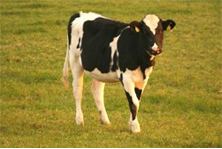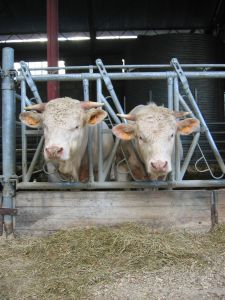With its abundant grasslands and large grain supply, the United States has developed a beef industry that is largely separate from its dairy sector. The United States has the largest fed-cattle industry in the world, and is the world's largest producer of beef, primarily high-quality, grain-fed beef for domestic and export use. The industry is roughly divided into two production sectors: cow-calf operations and cattle feeding.
Cattle Cycle
The cattle cycle refers to increases and decreases in the cattle herd over time, which arises because biological constraints prevent producers from instantly responding to price. In general, the cattle cycle is determined by the combined effects of cattle prices and the time needed to breed, birth, and raise cattle to market weight. If prices are expected to be high, producers slowly build up their herd size; if prices are expected to be low, producer draw down their herds. The cattle cycle may last as long as 8-12 years in duration, the longest of all meat animals.
Dry conditions that persisted from 1998 through 2003 held down the retention of heifers until forage conditions improved. By late 2003 and 2004, grazing conditions had improved. This, together with strong feeder calf prices, began the process of herd expansion through the addition of heifers and calves.
Cow-Calf Operations
Cow-calf operations are located throughout the United States, typically on land not suited or needed for crop production. These operations are dependent upon range and pasture forage conditions, which are in turn dependent upon variations in the average level of rainfall and temperature for the area. Beef cows harvest forage from grasslands to maintain themselves and raise a calf with very little, if any, grain input. The cow is maintained on pasture year round, as is the calf until it is weaned. If additional forage is available at weaning, some calves may be retained for additional grazing and growth until the following spring when they are sold. The average beef cow herd is 40 head, but operations with 100 or more beef cows comprise 9 percent of all beef operations and 51 percent of the beef cow inventory. Operations with 40 or fewer head are largely part of multi-enterprises, or are supplemental to off-farm employment.
Cattle feeding is concentrated in the Great Plains, but is also important in parts of the Corn Belt, Southwest, and Pacific Northwest. Cattle feedlots produce high-quality beef, grade Select or higher, by feeding grain and other concentrates for about 140 days. Depending on weight at placement, feeding conditions, and desired finish, the feeding period can be from 90 to as long as 300 days. Average gain is 2.5-4 pounds per day on about 6 pounds of dry-weight feed per pound of gain. While most of a calf's nutrient inputs until it is weaned are from grass, feedlot rations are generally 70 to 90 percent grain and protein concentrates.
Feedlots with less than 1,000 head of capacity comprise the vast majority of U.S. feedlots but market a relatively small share of fed cattle. In contrast, lots with 1,000 head or more of capacity comprise less than 5 percent of total feedlots but market 80-90 percent of fed cattle. Feedlots with 32,000 head or more of capacity market around 40 percent of fed cattle. The industry continues to shift toward a small number of very large specialized feedlots, which are increasingly vertically integrated with the cow-calf and processing sectors to produce high-quality fed beef.
CME Live Cattle Futures
Trade Unit 40,000 pounds
Point Descriptions 1 point = $.0001 per hundred pounds = $4.00
Live Cattle Futures Contract Listing Seven months in the Even Monthly Cycle: Feb, Apr, Jun, Aug, Oct, Dec.
Live Cattle Futures Ticker=LC GLOBEX=LE
Trading Venue: Floor Hours 9:05 a.m.-1:00 p.m.
Live Cattle Futures Limits $.030/lb, $1200
Minimum Fluctuation Regular 0.00025/lb=$10.00
Trading Venue: CME® Globex® Hours 9:05 a.m.-1:00 p.m.
CME Feeder Cattle Futures
Trade Unit 50,000 pounds
Point Descriptions 1 point = .0001 cents per pound = $5.00
Feeder Cattle Futures Contract Listing Jan, Mar, Apr, May, Aug, Sep, Oct and Nov.
Feeder Cattle Ticker=FC GLOBEX=GF
Hours 9:05 a.m.-1:00 p.m.
Feeder Cattle Minimum Fluctuation Regular 0.00025/lb=$12.50
Trading Venue: CME® Globex® Hours 9:05 a.m.-1:00 p.m.
Feeder Cattle Minimum Fluctuation Regular 0.00025/lb=$12.50
|






